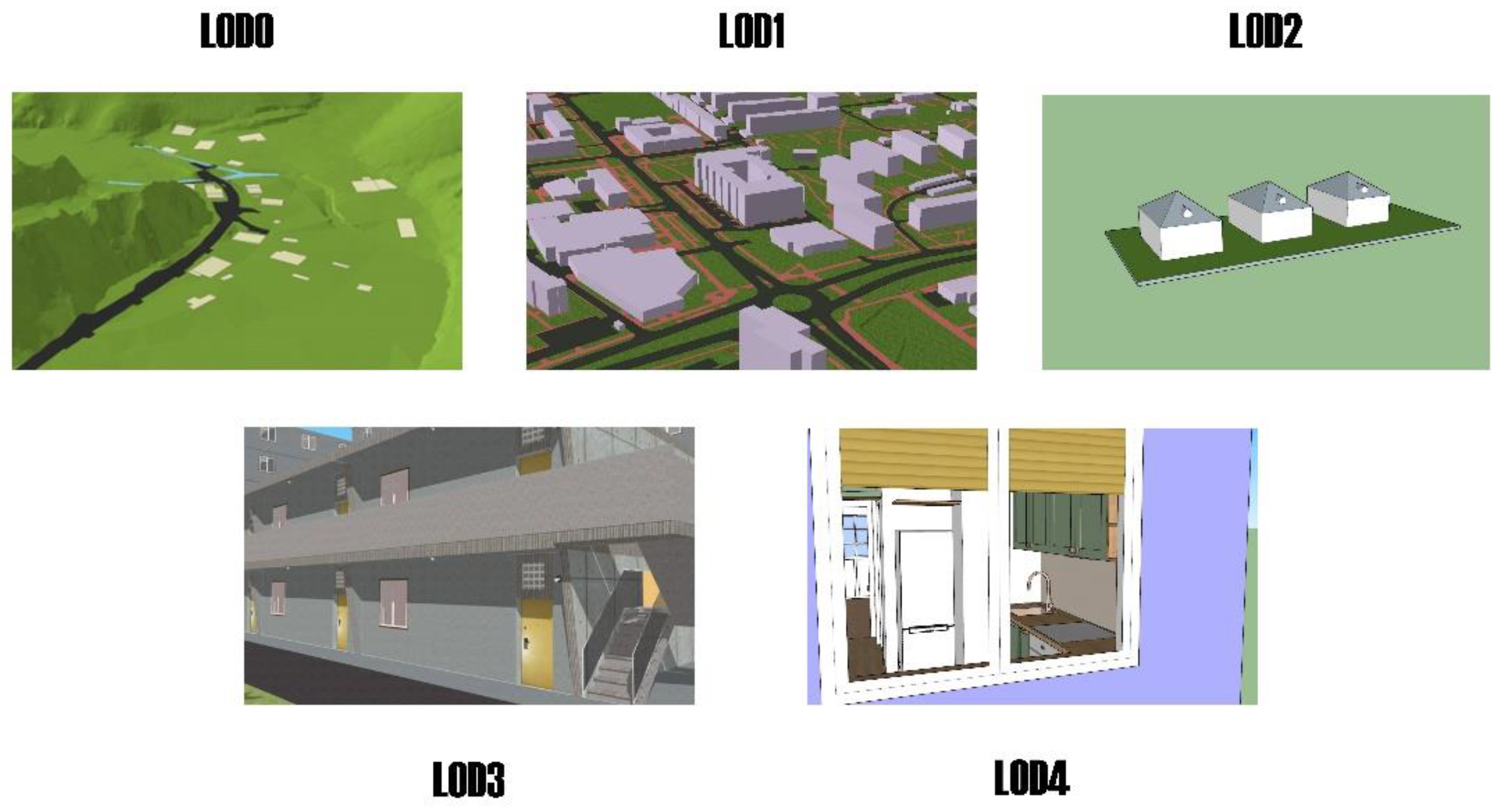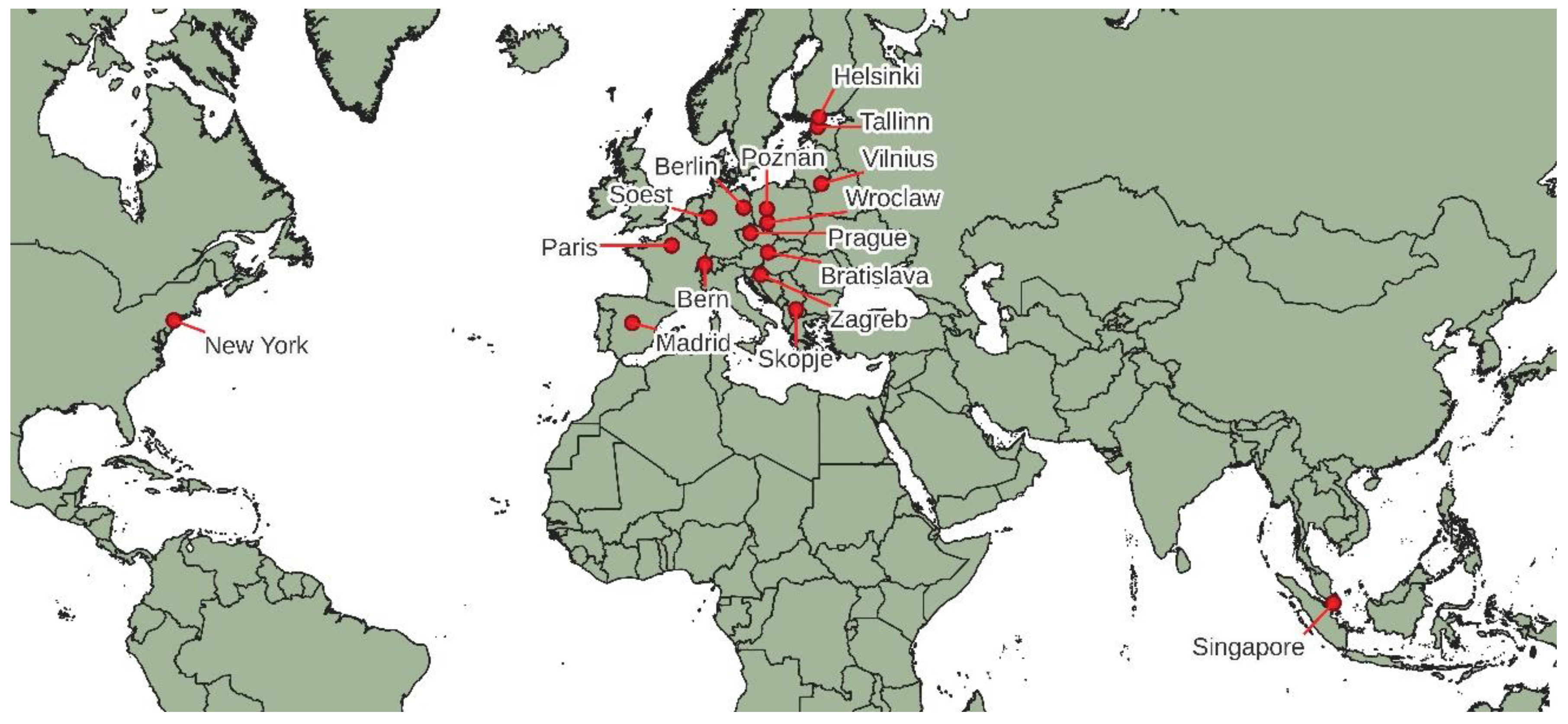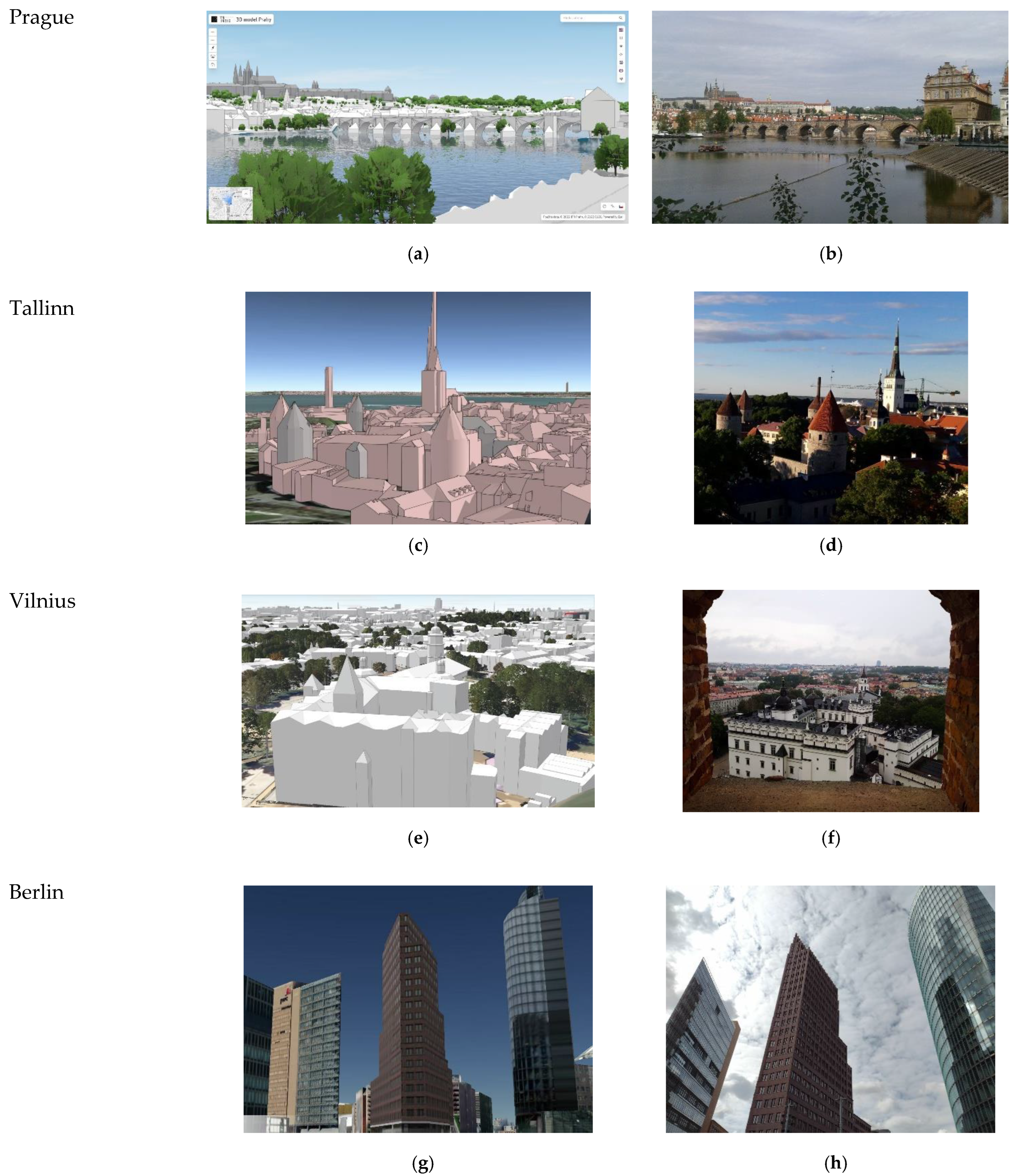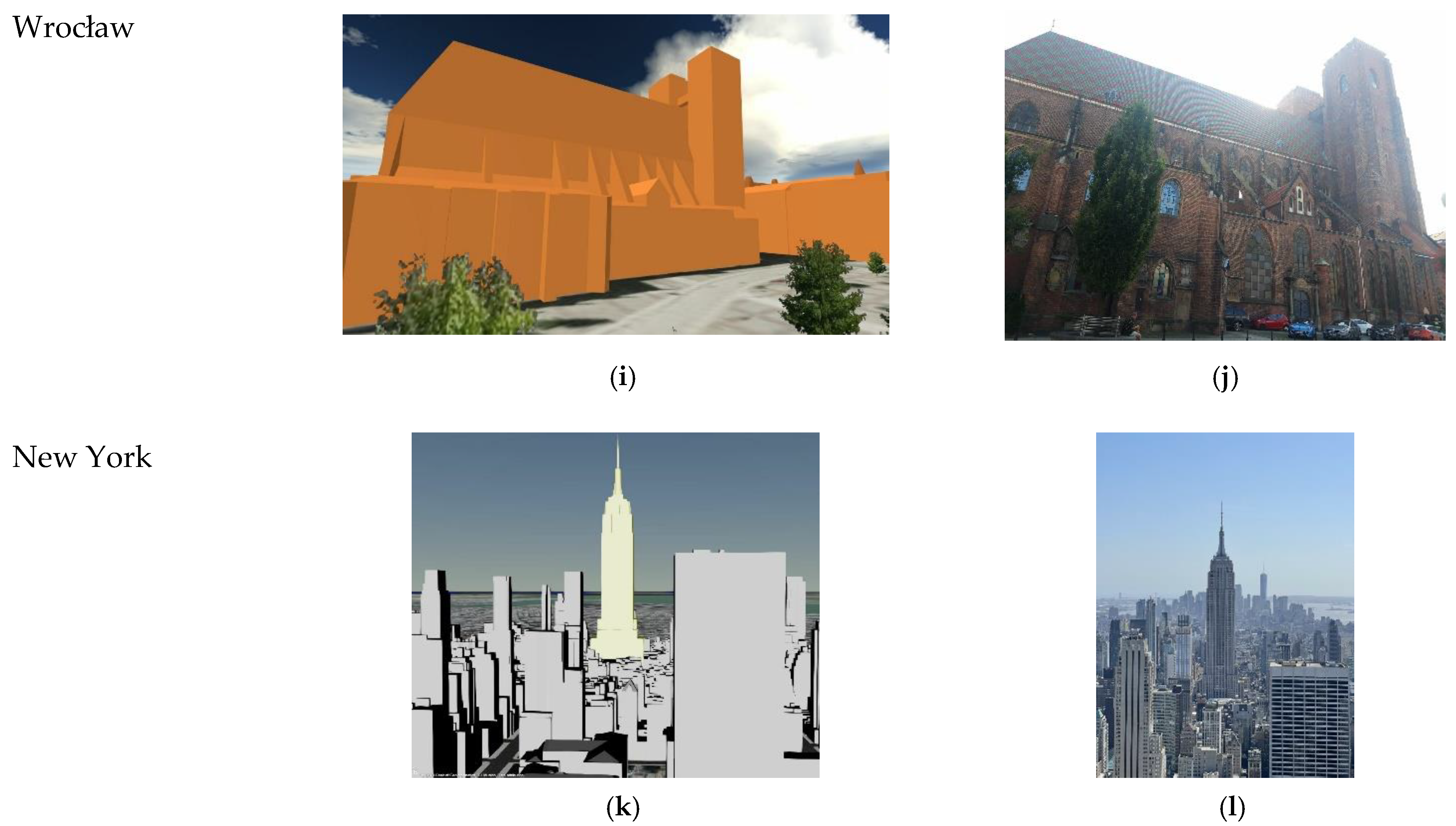Assessment of 3D Geoportals of Cities According to CityGML Standard Guidelines
Abstract
1. Introduction
2. Materials and Methods
3. Results
4. Discussion
5. Conclusions
Author Contributions
Funding
Institutional Review Board Statement
Informed Consent Statement
Data Availability Statement
Conflicts of Interest
References
- Śledziewska, K.; Włoch, R. Gospodarka Cyfrowa. Jak Nowe Technologie Zmieniają Świat; Forum Odpowiedzialnego Biznesu: Warszawa, Poland, 2020. [Google Scholar] [CrossRef]
- Ahlgren, B.; Hidell, M.; Ngai, E.C.H. Internet of Things for Smart Cities: Interoperability and Open Data. IEEE Internet Comput. 2016, 20, 52–56. [Google Scholar] [CrossRef]
- Biljecki, F.; Dehbi, Y. Raise the roof: Towards generating LOD2 models without aerial surveys using machine learning. ISPRS Ann. Photogramm. Remote Sens. Spat. Inf. Sci. 2019, 4, 27–34. [Google Scholar] [CrossRef]
- Kemeç, A. Analysis of smart city global research trends with network map technique. Manag. Res. Pract. 2022, 14, 46–59. [Google Scholar]
- Kolbe, T.; Moshrefzadeh, M.; Donaubauer, A.; Chaturvedi, K. The Data Integration Challenge in Smart City Projects; Technical Report; Lehrstuhl für Geoinformatik: München, Germany, 2020. [Google Scholar] [CrossRef]
- Mazur, Z.; Mazur, H.; Mendyk-Krajewska, T. Udostępnianie i wykorzystywanie danych otwartych. Èkon. Probl. Usł. 2017, 1, 211–221. [Google Scholar] [CrossRef][Green Version]
- Yao, Z.; Nagel, C.; Kunde, F.; Hudra, G.; Willkomm, P.; Donaubauer, A.; Adolphi, T.; Kolbe, T.H. 3DCityDB—A 3D geodatabase solution for the management, analysis, and visualization of semantic 3D city models based on CityGML. Open Geospat. Data Softw. Stand. 2018, 3, 1–26. [Google Scholar] [CrossRef]
- Hijazi, I.H.; Krauth, T.; Donaubauer, A.; Kolbe, T. 3DCityDB4BIM: A system architecture for linking BIM server and 3D CityDB for BIM-GIS-integration. ISPRS Ann. Photogramm. Remote Sens. Spat. Inf. Sci. 2020, 4, 195–202. [Google Scholar] [CrossRef]
- Arroyo Ohori, K.; Biljecki, F.; Kumar, K.; Ledoux, H.; Stoter, J. Modeling Cities and Landscapes in 3D with CityGML. In Building Information Modeling; Springer: Cham, Switzerland, 2018; pp. 199–215. [Google Scholar] [CrossRef]
- Ledoux, H.; Biljecki, F.; Dukai, B.; Kumar, K.; Peters, R.; Stoter, J.; Tom, C. 3dfier: Automatic reconstruction of 3D city models. J. Open Source Softw. 2021, 6, 2866. [Google Scholar] [CrossRef]
- Akahoshi, K.; Ishimaru, N.; Kurokawa, C.; Tanaka, Y.; Oishi, T.; Kutzner, T.; Kolbe, T.H. I-Urban revitalization: Conceptual modeling, implementation, and visualization towards sustainable urban planning using CityGML. ISPRS Ann. Photogramm. Remote Sens. Spat. Inf. Sci. 2020, 4, 179–186. [Google Scholar] [CrossRef]
- Vilgertshofer, S.; Amann, J.; Willenborg, B.; Borrmann, A.; Kolbe, T. Linking BIM and GIS Models in Infrastructure by Example of IFC and CityGML. In Proceedings of the ASCE International Workshop on Computing in Civil Engineering 2017, Seattle, WA, USA, 25–27 June 2017; pp. 133–140. [Google Scholar] [CrossRef]
- Stoter, J.; Ho, S.; Biljecki, F. Considerations for a contemporary 3D cadastre for our times. Int. Arch. Photogramm. Remote Sens. Spat. Inf. Sci. 2019, 4, 81–88. [Google Scholar] [CrossRef]
- Lim, J.; Tauscher, H.; Biljecki, F. Graph transformation rules for IFC-TO-CityGML attribute conversion. ISPRS Ann. Photogramm. Remote Sens. Spat. Inf. Sci. 2019, 4, 83–90. [Google Scholar] [CrossRef]
- Biljecki, F.; Lim, J.; Crawford, J.; Moraru, D.; Tauscher, H.; Konde, A.; Adouane, K.; Lawrence, S.; Janssen, P.; Stouffs, R. Extending CityGML for IFC-sourced 3D city models. Autom. Constr. 2021, 121, 103440. [Google Scholar] [CrossRef]
- Ates Aydar, S.; Stoter, J.; Ledoux, H.; Demir Ozbek, E.; Yomralioglu, T. Establishing a national 3D geo-data model for building data compliant to CityGML: Case of Turkey. Int. Arch. Photogramm. Remote Sens. Spat. Inf. Sci. 2016, 49, 7–86. [Google Scholar] [CrossRef]
- Biljecki, F.; Kumar, K.; Nagel, C. CityGML Application Domain Extension (ADE): Overview of developments. Open Geospat. Data, Softw. Stand. 2018, 3, 13. [Google Scholar] [CrossRef]
- Kolbe, T.H.; Kutzner, T.; Smyth, C.S.; Nagel, C.; Roensdorf, C.; Heazel, C. OGC 20-010 OGC City Geography Markup Language (CityGML) Part 1: Conceptual Model Standard. 2021. Available online: https://docs.ogc.org/is/20-010/20-010.html (accessed on 1 August 2022).
- Kutzner, T.; Chaturvedi, K.; Kolbe, T.H. CityGML 3.0: New Functions Open Up New Applications. PFG 2020, 88, 43–61. [Google Scholar] [CrossRef]
- Chaturvedi, K.; Kolbe, T.H. A requirement analysis on extending semantic 3D City models for supporting time-dependent properties. ISPRS Ann. Photogramm. Remote Sens. Spat. Inf. Sci. 2019, 4, 19–26. [Google Scholar] [CrossRef]
- Konde, A.; Tauscher, H.; Biljecki, F.; Crawford, J. Floor plans in CityGML. ISPRS Ann. Photogramm. Remote Sens. Spat. Inf. Sci. 2018, 4, 25–32. [Google Scholar] [CrossRef]
- Löwner, M.O.; Gröger, G.; Benner, J.; Biljecki, F.; Nagel, C. Proposal for a new LoD and multi-representation concept for CITYGML. ISPRS Ann. Photogramm. Remote Sens. Spat. Inf. Sci. 2016, 4, 3–12. [Google Scholar] [CrossRef]
- Beil, C.; Ruhdorfer, R.; Coduro, T.; Kolbe, T. Detailed Streetspace Modelling for Multiple Applications: Discussions on the Proposed CityGML 3.0 Transportation Model. ISPRS Int. J. Geo-Inf. 2020, 9, 603. [Google Scholar] [CrossRef]
- Beil, C.; Kolbe, T.H. Combined modelling of multiple transportation infrastructure within 3D city models and its implementation in CityGML 3.0. ISPRS Ann. Photogramm. Remote Sens. Spat. Inf. Sci. 2020, 4, 29–36. [Google Scholar] [CrossRef]
- Geoforum. Available online: https://geoforum.pl/news/29209/model-3d-poznania-gotowy-do-pobrania (accessed on 1 August 2022).
- Ciupa, S. Poznań w praktycznym modelu 3D. Przegląd Komunal. 2019, 4, 66–68. [Google Scholar]
- Kreisel, W.; Marsden, P.; Reeh, T. Die Landschaft Interpretieren: Interdisziplinäre Ansätze; ZELTForum-Göttinger Schriften Zu Landschaftsinterpretation und Tourismus; Göttingen University: Göttingen, Germany, 2021. [Google Scholar] [CrossRef]
- Lach, R.; Nawrocki, K.; Padee, A.; Zbyszewski, B.; Lessaer, S.; Sobieraj, L. A Shift from 2-D design Paradigm of XIX-Century to 3D/CityGML, BIM, 3D Printing and some of Smarter Cities in Poland. REAL CORP 2012 SMART ME UP! How to Become and Stay a Smart City, and does this improve Quality of Life? In Proceedings of the 21st International Conference on Urban Planning, Regional Development and Information Society, Hamburg, Germany, 22–24 June 2016; pp. 1015–1028. [Google Scholar]
- Tao, W. Interdisciplinary urban GIS for smart cities: Advancements and opportunities. Geo-spatial Inf. Sci. 2013, 16, 25–34. [Google Scholar] [CrossRef]
- Soon, K.H.; Khoo, V.H.S. Citygml modelling for singapore 3d national mapping. ISPRS Int. Arch. Photogramm. Remote Sens. Spat. Inf. Sci. 2017, 42, 37–42. [Google Scholar] [CrossRef]
- Berlin 3D–Downloadportal. Available online: http://www.businesslocationcenter.de/berlin3d-downloadportal/?lang=en#/export (accessed on 1 August 2022).
- Trojrozmerný Model Budov. Available online: http://www.archinfo.sk/diskusia/blog/architektura-vseobecne/magistrat-bratislavy-zverejnil-prve-styri-3d-mapove-aplikacie-zachytavajuce-mesto.html (accessed on 1 August 2022).
- 3D-Stadtmodell Bern. Available online: https://map.bern.ch/3d-stadtmodell/ (accessed on 1 August 2022).
- Helsingin 3D-Kaupunkimallit. Available online: http://kartta.hel.fi/3d/#/ (accessed on 1 August 2022).
- VISOR 3D Comunidad de Madrid. Available online: http://idem.madrid.org/visor/3D/ (accessed on 1 August 2022).
- NYC Detailed Road Model. Available online: http://linkd.pl/pffs4 (accessed on 1 August 2022).
- Géoportail. Available online: http://www.geoportail.gouv.fr/plan/75056/paris (accessed on 1 August 2022).
- Poznań. Available online: http://sip.poznan.pl/model3d/#/legend (accessed on 1 August 2022).
- 3D Model Prahy. Available online: http://app.iprpraha.cz/apl/app/model3d/ (accessed on 1 August 2022).
- One Map 3.0. Available online: http://www.onemap3d.gov.sg/main/ (accessed on 1 August 2022).
- 3D Smart City–Skopje. Available online: https://gdi-sk.maps.arcgis.com/apps/Styler/index.html?appid=98d55ddd1bb64d8a8b787b2fa5634580&fbclid=IwAR2uoINqSvoDaRJ5xSmAAMsutRQHJ93OlbTUHeYMK7_9IiFSB3yOCxpvtZM (accessed on 1 August 2022).
- 3D-Stadtmodell der Stadt Soest. Available online: https://soest.virtualcitymap.de/#/ (accessed on 1 August 2022).
- Maa-Amet 3D. Available online: http://3d.maaamet.ee/kaart/ (accessed on 1 August 2022).
- 3D Vilnius. Available online: https://3d.vilnius.lt/scenos/3d-miesto-maketas (accessed on 27 October 2022).
- System Informacji Przestrzennej Wrocławia. Available online: http://gis.um.wroc.pl/imap3d/ (accessed on 1 August 2022).
- ZG3D: 3D Model Grada Zagreba. Available online: https://zagreb.gdi.net/zg3d/?fbclid=IwAR0lLigxq8bqGukHXp_WhCepDmCMSTJE3CiVIDOPN4MoWua2UxT0UlP7JZY (accessed on 1 August 2022).
- Santhanavanich, T.; Coors, V. CityThings: An integration of the dynamic data to the 3D city model. Environ. Plan. B Urban Anal. City Sci. 2021, 48, 417–432. [Google Scholar] [CrossRef]
- European Parliament; Council of the European Union. Directive 2007/2/EC of the European Parliament and of the Council of 14 March 2007 Establishing an Infrastructure for Spatial Information in the European Community (INSPIRE); Publications Office of the European Union: Luxembourg, 2007. [Google Scholar]




| Ranking of the Analysed Geoportals with Scores Assigned for Respective Criteria | ||||||||||||||||||||||
|---|---|---|---|---|---|---|---|---|---|---|---|---|---|---|---|---|---|---|---|---|---|---|
| Ranking Position | City | LoD1 | LoD2 | LoD3 | Textures | Bridges | Walkways | Curbs | Roadways | Car Parks | Vegetation | Other Elements of the Urban Space | Waterbody | Spatial Planning | Point Cloud | Mesh | Export Formats | WMS | Dynamiser | Natural Light | IoT | Total Points |
| 1 | Poznań | 0 | 1 | 0.5 | 1 | 0 | 0 | 0 | 0 | 0 | 1 | 1 | 0 | 1 | 1 | 1 | 1 | 1 | 0 | 0 | 1 | 10.5 |
| 2 | Zagreb | 0 | 1 | 0 | 0 | 1 | 0 | 0 | 0 | 0 | 1 | 0 | 1 | 1 | 1 | 0.5 | 0 | 1 | 0 | 1 | 0 | 8.5 |
| 3 | Vilnius | 0 | 1 | 0.5 | 0 | 1 | 0 | 0 | 0 | 0 | 1 | 0 | 0 | 1 | 0 | 1 | 0 | 0 | 1 | 1 | 0 | 7.5 |
| 4 | New York | 0 | 1 | 0 | 0 | 0 | 1 | 1 | 1 | 1 | 0 | 0 | 0 | 0 | 0 | 0 | 0 | 1 | 1 | 0 | 0 | 7 |
| 4 | Wrocław | 1 | 1 | 0 | 0 | 1 | 0 | 0 | 0 | 0 | 1 | 0 | 1 | 0 | 0 | 0 | 0 | 1 | 0 | 1 | 0 | 7 |
| 5 | Bern | 0 | 1 | 0 | 0 | 1 | 0 | 0 | 0 | 0 | 1 | 1 | 1 | 0 | 0.5 | 0 | 0 | 0 | 0 | 1 | 0 | 6.5 |
| 6 | Prague | 0 | 1 | 0 | 0 | 1 | 0 | 0 | 0 | 0 | 1 | 0 | 1 | 1 | 0 | 0 | 0 | 0 | 0 | 1 | 0 | 6 |
| 6 | Singapore | 0 | 1 | 0 | 1 | 0 | 0 | 0 | 0 | 0 | 0 | 1 | 0 | 0 | 0 | 0 | 0 | 0 | 1 | 1 | 1 | 6 |
| 7 | Berlin | 0 | 1 | 0 | 1 | 0 | 0 | 0 | 0 | 0 | 0 | 0 | 0 | 0 | 0 | 1 | 1 | 1 | 0 | 0 | 0 | 5 |
| 7 | Helsinki | 0 | 1 | 0 | 1 | 0 | 0 | 0 | 0 | 0 | 0 | 0 | 0 | 0 | 0 | 1 | 1 | 0 | 0 | 1 | 0 | 5 |
| 7 | Soest | 0 | 1 | 0 | 1 | 0 | 0 | 0 | 0 | 0 | 0 | 1 | 0 | 0 | 0 | 1 | 1 | 0 | 0 | 0 | 0 | 5 |
| 8 | Tallinn | 1 | 1 | 0 | 0.5 | 0 | 0 | 0 | 0 | 0 | 0 | 0 | 0 | 0 | 0 | 0 | 1 | 0 | 0 | 1 | 0 | 4.5 |
| 9 | Bratislava | 1 | 0.5 | 0 | 1 | 0 | 0 | 0 | 0 | 0 | 1 | 0 | 0 | 0 | 0 | 0 | 0 | 0 | 0 | 0 | 0 | 3.5 |
| 10 | Paris | 1 | 0 | 0 | 0 | 0 | 0 | 0 | 0 | 0 | 0 | 0 | 0 | 1 | 0 | 0 | 0 | 0 | 0 | 0 | 0 | 2 |
| 10 | Skopje | 0 | 1 | 0 | 0 | 0 | 0 | 0 | 0 | 0 | 0 | 0 | 0 | 1 | 0 | 0 | 0 | 0 | 0 | 0 | 0 | 2 |
| 11 | Madrid | 0 | 0.5 | 0 | 1 | 0 | 0 | 0 | 0 | 0 | 0 | 0 | 0 | 0 | 0 | 0 | 0 | 0 | 0 | 0 | 0 | 1.5 |
| The Number of Occurrences of the Examined Elements in Three-Dimensional Geoportals of Cities | |
|---|---|
| Elements | Number of Occurrences |
| LoD2 | 15 |
| textures | 8 |
| natural light | 8 |
| vegetation | 7 |
| spatial planning | 6 |
| mesh | 6 |
| bridges | 5 |
| export formats | 5 |
| WMS | 5 |
| LoD1 | 4 |
| other elements of the urban space | 4 |
| waterbody | 4 |
| point cloud | 3 |
| dynamizer | 3 |
| LoD3 | 2 |
| IoT | 2 |
| walkways | 1 |
| curbs | 1 |
| roadways | 1 |
| car parks | 1 |
| tunnels | 0 |
Publisher’s Note: MDPI stays neutral with regard to jurisdictional claims in published maps and institutional affiliations. |
© 2022 by the authors. Licensee MDPI, Basel, Switzerland. This article is an open access article distributed under the terms and conditions of the Creative Commons Attribution (CC BY) license (https://creativecommons.org/licenses/by/4.0/).
Share and Cite
Maciąg, K.; Leń, P. Assessment of 3D Geoportals of Cities According to CityGML Standard Guidelines. Sustainability 2022, 14, 15578. https://doi.org/10.3390/su142315578
Maciąg K, Leń P. Assessment of 3D Geoportals of Cities According to CityGML Standard Guidelines. Sustainability. 2022; 14(23):15578. https://doi.org/10.3390/su142315578
Chicago/Turabian StyleMaciąg, Klaudia, and Przemysław Leń. 2022. "Assessment of 3D Geoportals of Cities According to CityGML Standard Guidelines" Sustainability 14, no. 23: 15578. https://doi.org/10.3390/su142315578
APA StyleMaciąg, K., & Leń, P. (2022). Assessment of 3D Geoportals of Cities According to CityGML Standard Guidelines. Sustainability, 14(23), 15578. https://doi.org/10.3390/su142315578







